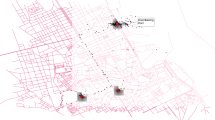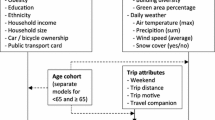Abstract
The aim of this research is to identify the relationship between activity patterns and route choice decisions. The focus is twofold: on the one hand, the relationship between the purpose of a trip and the road categories used for the relocation is investigated; on the other hand, the relationship between the purpose of a trip and the deviation from the shortest path is studied. The data for this study were collected in 2006 and 2007 in Flanders, the Dutch speaking and northern part of Belgium. To estimate the relationship between the primary road category travelled on and the corresponding activity-travel behaviour a multinomial logit model is developed. To estimate the relationship between the deviation from the shortest path and the corresponding activity-travel behaviour a Tobit model is developed. The results of the first model point out that route choice is a function of multiple factors, not just travel time or distance. Crucial for modelling route choices or in general for traffic assignment procedures is the conclusion that activity patterns have a clear influence on the road category primarily driven on. Particularly, it was shown that the likelihood of taking primarily through roads is highest for work trips and lowest for leisure trips. The second model shows a significant relationship between the deviation from the shortest path and the purpose of the trip. Furthermore, next to trip-related attributes (trip distance), also socio-demographic variables and geographical differences play an important role. These results certainly suggest that traffic assignment procedures should be developed that explicitly take into account an activity-based segmentation. In addition, it was shown that route choices were similar during peak and off-peak periods. This is an indication that car drivers are not necessarily utility maximizers, or that classical utility functions in the context of route choices are omitting important explanatory variables.

Similar content being viewed by others
References
Abdel-Aty MA, Huang Y (2004) Exploratory spatial analysis of expressway ramps and its effects on route choice. J Transp Eng 130(1):104–112
Abdel-Aty MA, Kitamura R, Jovanis PP (1997) Using stated preference data for studying the effect of advanced traffic information on drivers’ route choice. Transp Res C 5(1):39–50
Amemiya T (1984) Tobit models: a survey. J Econom 24:3–61
Avineri E, Prashker J (2004) Violations of expected utility theory in route-choice stated preferences: certainty effect and inflation of small probabilities. Transp Res Rec 1894:222–229
Bayarma A, Kitamura R, Susilo Y (2007) Recurrence of daily travel patterns: stochastic process approach to multiday travel behavior. Transp Res Rec 2021:55–63
Bekhor S, Ben-Akiva M, Ramming M (2006) Evaluation of choice set generation algorithms for route choice models. Ann Oper Res 144(1):235–247
Bellemans T, Kochan B, Janssens D, Wets G, Timmermans H (2008) Field evaluation of personal digital assistant enabled by global positioning system: impact on quality of activity and diary data. Transp Res Rec 2049:136–143
Chen BY, Lam WHK, Sumalee A, Li Q, Shao H, Fang Z (2012) Finding reliable shortest paths in road networks under uncertainty. Netw Spat Econ. doi:10.1007/s11067-012-9175-1
Cirillo C, Cornelis E, Toint PL (2012) A Model of weekly labor participation for a Belgian synthetic population. Netw Spat Econ 12(1):59–73
Cools M, Moons E, Wets G (2009) Investigating the variability in daily traffic counts 16 through use of ARIMAX and SARIMAX models: assessing the effect of holidays on two site locations. Transp Res Rec 2136:57–66
Cools M, Moons E, Creemers L, Wets G (2010a) Changes in travel behavior in response to weather conditions: do type of weather and trip purpose matter? Transp Res Rec 2157:22–28
Cools M, Moons E, Wets G (2010b) Assessing the impact of public holidays on travel time expenditure: differentiation by trip motive. Transp Res Rec 2157:29–37
Cools M, Moons E, Wets G (2010c) Assessing the impact of weather on traffic intensity. Weather Clim Soc 2(1):60–68
Davidson W, Donnelly R, Vovsha P, Freedman J, Ruegg S, Hicks J, Castiglione J, Picado R (2007) Synthesis of first practices and operational research approaches in activity-based travel demand modeling. Transp Res A 41:454–488
de Palma A, Picard N (2005) Route choice decision under travel time uncertainty. Transp Res A Policy Pract 39(4):295–324
Duffel J, Kalombaris A (1988) Empirical studies of car driver route choice in Hertfordshire. Traffic Eng Control 29(7/8):398–408
Flötteröd G, Chen Y, Nagel K (2012) Behavioral calibration and analysis of a large-scale travel microsimulation. Netw Spat Econ 12(4):481–502
Goldenbeld C, Drolenga J, Smits A (2007) Routekeuze van automobilisten. Resultaten van een vragenlijstonderzoek R-2006–33:116
Han Q, Timmermans HJP, Dellaert BGC, van Raaij F (2008) Route choice under uncertainty: effects of recommendations. Transp Res Rec 2082:72–80
Hoffman SD, Duncan GK (1988) Multinomial and conditional logit discrete-choice models in demography. Demography 25(3):415–427
Huang A, Levinson D (2012) Accessibility, network structure, and consumers’ destination choice: a GIS analysis of GPS travel data. Proceedings of the 91st Annual Meeting of the Transportation Research Board. Transportation Research Board of the National Academies, Washington, D.C
Huchingson R, McNees R, Dudek C (1977) Survey of motorist route-selection criteria. Transp Res Rec 643:45–48
Jackson W, Jucker J (1981) An empirical study of travel time variability and travel choice behaviour. Transp Sci 16(4):460–475
Jan O, Horowitz A, Peng Z-R (2000) Using global positioning system data to understand variations in path choice. Transp Res Rec 1725:37–44
Jou R, Mahmassani H (1994) Comparability and transferability of commuter behaviour characteristics between cities: departure time and route switching decisions. Presented at the 73rd Annual Meeting of the Transportation Research Board
Kaplan S, Prato CG (2012) Closing the gap between behavior and models in route choice: the role of spatiotemporal constraints and latent traits in choice set formation. Transp Res F 15:9–24
Levinson D, El-Geneidy A (2009) The minimum circuity frontier and the journey to work. Reg Sci Urban Econ 39(6):732–738
Levinson D, Zhu S (2012) The hierarchy of roads, the locality of traffic, and governance. Transp Policy 19:147–154
Li H (2004) Investigating morning commute route choice behavior using global positioning systems and multi-day travel data. PhD thesis, Georgia Institute of Technology, GA
Li H, Guensler R, Ogle J (2005) Analysis of morning commute route choice patterns using global positioning system-based vehicle activity data. Transp Res Rec 1926:162–170
Mannering F, Kim S-G, Barfield W, Ng L (1994) Statistical analysis of commuters’ route, mode and departure time flexibility. Transp Res C 2(1):35–47
Marquardt DW (1980) You should standardize the predictor variables in your regression models. J Am Stat Assoc 75(369):74–103
McDonald FF, Moffitt RA (1980) The uses of tobit analysis. Rev Econ Stat 62(2):318–321
Miermans W, Janssens D, Cools M, Wets G (2010) Onderzoek verplaatsingsgedrag vlaanderen 4.1 (2008-2009): verkeerskundige interpretatie van de belangrijkste gegevens. Transportation Research Institute, Hasselt University, Diepenbeek, Belgium
Montgomery DC, Runger GC (2003) Applied statistics and probability for engineers, 4th edn. John Wiley and Sons, New York
Murakami E, Wagner DP (1999) Can using global positioning system (GPS) improve trip reporting? Transp Res C Emerg Technol 7(2–3):149–165
Papinski D, Scott DM, Doherty ST (2009) Exploring the route choice decision-making process: a comparison of planned and observed routes obtained using person-based GPS. Transp Res F Traffic Psychol Behav 12(4):347–358
Parkany E, Du J, Aultman-Hall L, Gallagher R (2006) Modeling stated and revealed route choice: consideration of consistency, diversion, and attitudinal variables. Transp Res Rec 1985:29–39
Parthasarathi P (2011) Network structure and travel. PhD dissertation, University of Minnesota
Parthasarathi P, Hochmair H, Levinson D (2012) Network structure and spatial separation. Environ Plan B Plan Des 39(1):137–154
Peeta S, Yu JW (2005) A hybrid model for driver route choice incorporating en-route attributes and real-time information effects. Netw Spat Econ 5:21–40
Prato CG (2009) Route choice modeling: past, present and future research directions. J Choice Model 2(1):65–100
Prato C, Bekhor S (2006) Applying brand-and-bound techniques to route choice set generation. Transp Res Rec 1985(1):19–28
Qian Z, Zhang HM (2012) A hybrid route choice model for dynamic traffic assignment. Netw Spat Econ. doi:10.1007/s11067-012-9177-z
Ramadurai G, Ukkusuri S (2010) Dynamic User equilibrium model for combined activity-travel choices using activity-travel supernetwork representation. Netw Spat Econ 10(2):273–292
Ramming MS (2002) Network knowledge and route choice PhD-thesis, Massachusetts Institute of Technology
Scheiner J (2010) Social inequalities in travel behaviour: trip distances in the context of residential self-selection and lifestyles. J Transp Geogr 18:679–690
Schuessler N, Balmer M, Axhausen KW (2010) Route choice sets for very high-resolution data. Proceedings of the 89th Annual Meeting of the Transportation Research Board. CD-ROM. Transportation Research Board of the National Academies, Washington, D.C.
Spissu E, Meloni I, Sanjust B (2011) Behavioral analysis of choice of daily route with data from global positioning system. Transp Res Rec 2230:96–103
Tobin J (1958) Estimation of relationships for limited dependent variables. Econometrica 26(1):24–36
Wachs M (1967) Relationships between drivers’ attitudes toward alternate routes and driver and route characteristics. Highw Res Rec 197:70–87
Weijermars W, Gitelman V, Papadimitriou E, Lima de Azevedo C (2008) Safety performance indicators for the road network. Proceedings of the European Transport Conference 2008. CD-ROM. The Netherlands: Association for European Transport
Wolf J, Hallmark S, Oliveira M, Guensler R, Sarasua W (1999) Accuracy issues with route choice data collection by using global positioning system. Highw Res Rec 1660:66–74
Zhang L, Levinson D (2008) Determinants of route choice and value of traveler information: a field experiment. Highw Res Rec 2086:81–92
Zhu S (2010) The roads taken: theory and evidence on route choice in the wake of the I-35 W Mississippi River Bridge Collapse and Reconstruction. Ph.D. Dissertation, University of Minnesota
Author information
Authors and Affiliations
Corresponding author
Rights and permissions
About this article
Cite this article
Ramaekers, K., Reumers, S., Wets, G. et al. Modelling Route Choice Decisions of Car Travellers Using Combined GPS and Diary Data. Netw Spat Econ 13, 351–372 (2013). https://doi.org/10.1007/s11067-013-9184-8
Published:
Issue Date:
DOI: https://doi.org/10.1007/s11067-013-9184-8




